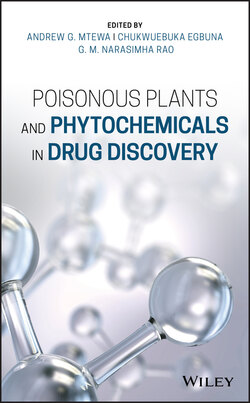Читать книгу Poisonous Plants and Phytochemicals in Drug Discovery - Группа авторов - Страница 24
1.8 Toxic Psychoactive Plants for Recreational and Religious Purposes
ОглавлениеAll cultures around the world have some kind of drug culture that relies on psychoactive compounds for medicinal, recreational, or ritual purposes [62]. Psychoactive substances are compounds that have the ability to change consciousness, mood, and thoughts [63]. Psychoactive plant species contain compounds that work as hallucinogenics, sedatives, or stimulants [64, 65].
Alrashedy and Molina [64] conducted a phylogenetic analysis of 126 traditionally used psychoactive plants that indicates multiple ethnobotanical origins. The plant species documented were also used for several medicinal purposes. Rätsch [66] presented a detailed account of psychoactive plants. Some of the well‐known psychoactive plant species with medicinal, recreational, and other purposes include Cannabis spp. (marijuana), which has hallucinogenic, stimulant, antianxiety, antidepressant, sedative, analgesic, and aphrodisiac properties; Atropa belladonna (belladonna), which has hallucinogenic, stimulant, sedative, and aphrodisiac properties; and Papaver somniferum (opium poppy), Datura spp., and Mandragora spp. (mandrake), which all have hallucinogenic, sedative, analgesic, and aphrodisiac properties. In addition, Catha edulis (khat) has stimulant, antidepressant, and aphrodisiac properties.
Some plants containing psychoactive substances should be classified as harmful drugs since chronic administration has been linked to addiction and cognitive impairment [65]. Not much is known about the toxicity of many of the psychoactive plant species, mainly because of the limited number of studies conducted on their toxicity. A case in point is Datura stramonium, in which all parts are toxic. The plant contains a mixture of anticholinergic alkaloids such as atropine, hyoscyamine, and scopolamine, which are mainly responsible for its neurotoxic and hallucinogenic effects [67]. Datura has a narrow therapeutic window, implying a small difference between the active and lethal dose. It has been widely documented as a cause of accidental poisoning, particularly in contaminated food [68]. Another example is C. edulis, the consumption of which has been associated with several cases of acute liver failure and autoimmune hepatitis [69].
